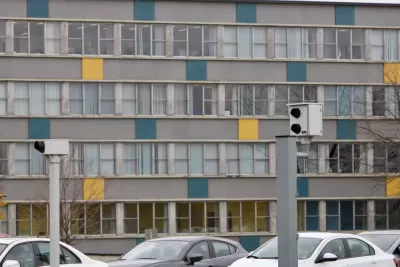Analysis of the automated enforcement program in Ottawa, Canada shows a significant drop in speeding near traffic cameras.

A recent study from Canada highlights the success of Ottawa’s automated traffic enforcement cameras, which, at one location near a school, quadrupled compliance with speed limits. Alistair Steele reports on the story for CBC News.
“Last month, the city announced plans to more than double the number of automated speed enforcement (ASE) cameras monitoring its roads in 2023 from 17 to 40, and to add up to 25 more annually until 2026, creating a web of ASE zones so vast that it could soon become difficult to drive from point A to point B in Ottawa without passing through at least one.” Rather than focusing on schools and parks, the new cameras will be located in “community safety zones” where speeding is a major problem.
In the United States, where traffic cameras are a contentious issue, more policymakers are recognizing their benefits. While proponents say the cameras can help limit interaction with police and improve road safety, critics caution that the programs can disproportionately impact people of color, in large part because low-income neighborhoods often lack safe infrastructure.
As Steele points out, Ottawa isn’t alone in its success with traffic cameras. “A systematic review published by the Cochrane Library in 2010 analyzed 35 separate studies from around the world and found average speeds in the vicinity of ASE cameras dropped by up to 15 per cent.” The same analysis also found a significant reduction in crashes, correlating with fewer injuries and deaths, near cameras.
FULL STORY: Here's the really annoying thing about speed cameras: They work

Alabama: Trump Terminates Settlements for Black Communities Harmed By Raw Sewage
Trump deemed the landmark civil rights agreement “illegal DEI and environmental justice policy.”

Planetizen Federal Action Tracker
A weekly monitor of how Trump’s orders and actions are impacting planners and planning in America.

The 120 Year Old Tiny Home Villages That Sheltered San Francisco’s Earthquake Refugees
More than a century ago, San Francisco mobilized to house thousands of residents displaced by the 1906 earthquake. Could their strategy offer a model for the present?

LA’s Tree Emergency Goes Beyond Vandalism
After a vandal destroyed dozens of downtown LA trees, Mayor Karen Bass vowed to replace them. Days later, she slashed the city’s tree budget.

Sacramento Leads Nation With Bus-Mounted Bike Lane Enforcement Cameras
The city is the first to use its bus-mounted traffic enforcement system to cite drivers who park or drive in bike lanes.

Seattle Voters Approve Social Housing Referendum
Voters approved a corporate tax to fund the city’s housing authority despite an opposition campaign funded by Amazon and Microsoft.
Urban Design for Planners 1: Software Tools
This six-course series explores essential urban design concepts using open source software and equips planners with the tools they need to participate fully in the urban design process.
Planning for Universal Design
Learn the tools for implementing Universal Design in planning regulations.
Ada County Highway District
Clanton & Associates, Inc.
Jessamine County Fiscal Court
Institute for Housing and Urban Development Studies (IHS)
City of Grandview
Harvard GSD Executive Education
Toledo-Lucas County Plan Commissions
Salt Lake City
NYU Wagner Graduate School of Public Service





























